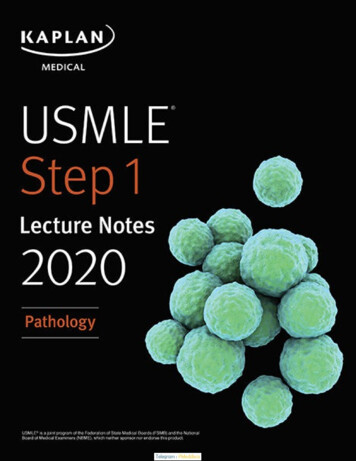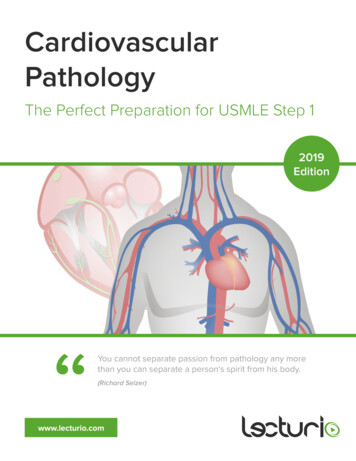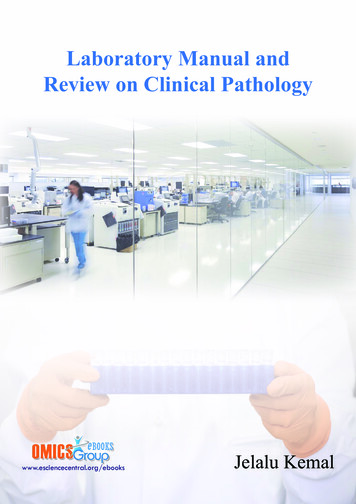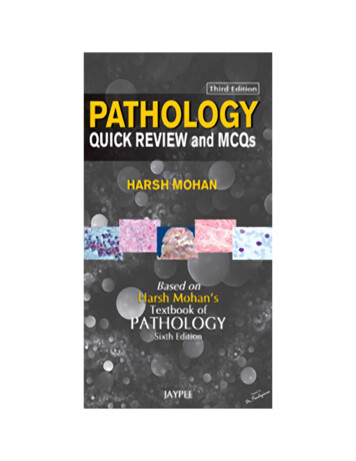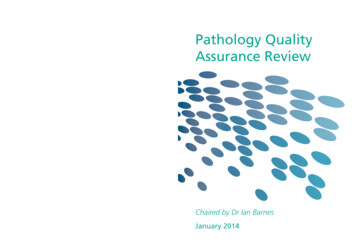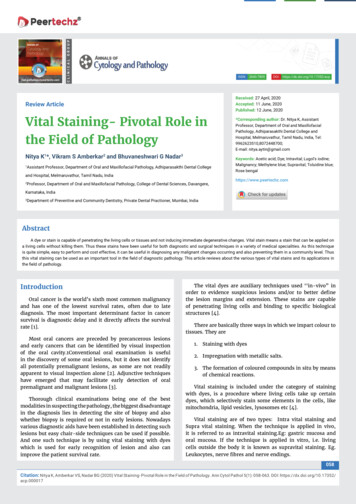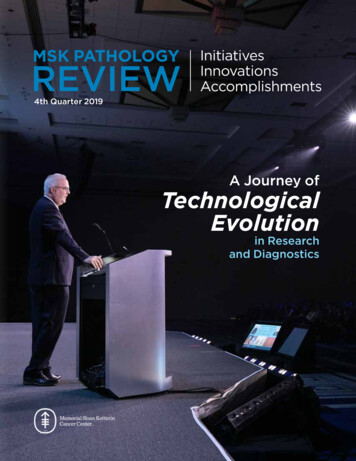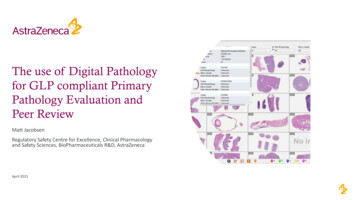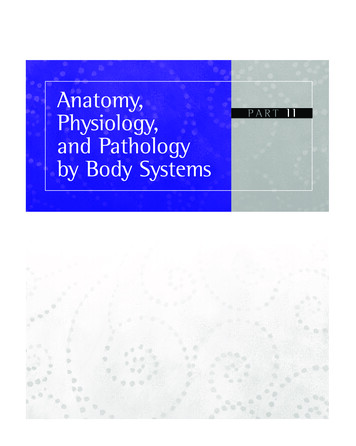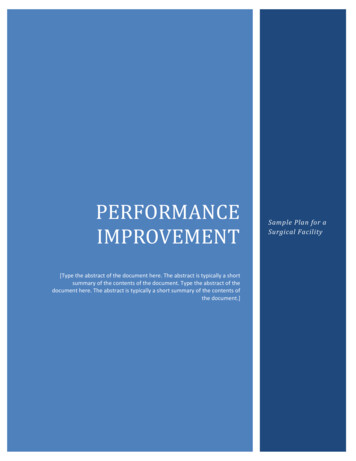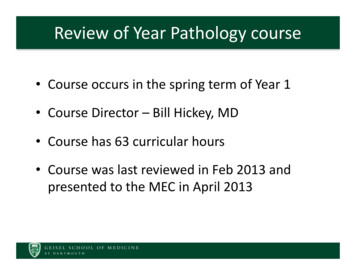
Transcription
Review of Year Pathology course Course occurs in the spring term of Year 1 Course Director – Bill Hickey, MD Course has 63 curricular hours Course was last reviewed in Feb 2013 andpresented to the MEC in April 2013
Action Plan from Prior Review During the discussion of the course in 2013, the MECrequested that Dr. Hickey submit in writing an actionplan to address issues raised during the review The document was never received, thus it is notpossible to assess whether the action plan wasimplemented Many of the issues raised by students during AY2011-2012 were also mentioned in AY 2014-2015
Course Objectives*Note: typos were found in the objectives on Canvas; these are highlighted in red1. Describe the general field of pathology and discuss its relation to other medicaldisciplins and regulatory bodies.2. Define at least six distinct pathogenetic processes by which human disease can occur.3. Give at least two examples of diseases that fit into each pathogenetic category.4. Discuss developmental diseases in the context of normal and abnormal embryogenesis.5. Discuss the features of lethal and sublethal cell injury.6. Identify and discuss cellular atrophy, hyperplasia, dysplasia and neoplasia7. Discuss disorders of the blood and circularory system including edema, arteriosclerosisand the evolution of ischemic injury and infarction8. Diagram the coagulation cascade and discuss clotting and bleeding disorders.9. Describe the processes in the evolution of acute and chronic inflammation aswell as thesignificance and consequences.10. Name four complications of chronic inflammation.11. Detail in a step-by-step manner the process of normal wound healing.12. Describe the pathogenesis, pathology and resistance factors associated with variousdiseases caused by bacteria.
Course Objectives (cont.)13. Define the pathogenic mechanisms and give examples of chronic and opportunisticpathogens.14. Discuss the pathological events in viral infections.15. Define, distinguish and explain hypersensitivity diseases types I through IV.16. Explain tolerance in the immune system and how autoimmune diseases could develop,giving examples of three.17. Discuss the pathophysiology of immunodeficiency and the four primaryimmunodeficiency disorders and detail what they involve.18. Discuss the pathogenesis of HIV infection in terms of the HIV genome.19. List the most common neoplastic conditions and the four features shared by all.20. Describe the patholigic features of neoplasms and distinguish [objective cut off onCanvas]21. Explain the process of grading a tumor and the TMN staging system for tumors.22. Describe malignant transformation and three genetic abnormalities that give rise tocancer syndromes.23. Discuss epigenetic influences in the maintenance of normal cellular homeostasis.24. Describe mechanisms by which neoplasms evade immunological elimination.
Course Objectives (cont.)25. Explain the role of the medical examiner in medicine and jurisprudence and when a death or illnessmust be investigated by the medical examiner.26. Explain the importance of autopsies and the processes of obtaining and conducting them.27. Explain the mechanism and give examples of environmental exposures, toxin, poisons andmedications causing illness.28. Discuss the pathogenesis of diseases caused by alcohol and cigarette smoking.29. Correlate signs, symptoms, clinical presentations and treatments with underlying pathological,pathophysilogical and epidemiological characteristics.30. Discuss clinical laboratory studies and clinical pathology principles, including sources of error, inmedical practice.31. To communicate effectively and collegially with colleagues and faculty in small group exercises andlabs.32. To behave respectfully and responsibly towards colleagues and faculty in small group exercises andlabs.33. To meet professional responsibilities fully.34. To adhere to high ethical and moral standards, accept responsibility for personal actions and acceptconstructive criticism in small group exercises and labs.35. Take responsibility for his- or her-own medical education by preparation for small group exercisesand labs.36. To set up, use and troubleshoot a microscope.
Mapping of Course Objectives (1 of 2)
Mapping of Course Objectives (2 of 2)
Course Objectives – Comments There is no specific section in the NBME Step Ibrochure for Pathology, however session objectivescover content in many sections of the brochureincluding:Biology of the CellsBiology of tissue response to diseaseHemopoietic and Lymphoreticular SystemsCentral and Peripheral Nervous SystemsCardiovascular SystemsImmune SystemRespiratory system
Objectives Suggestions There are too many course objectives – 8 to 15 objectives isstandard practice; some of the current objectives are moreappropriate for session objectives. Currently there are too many objectives without“searchable” words included. This prohibits searches forredundancy and should be changed. Many objectives map to Competency 1c. A few of thesecan be combined and written with more search words.– Example Objectives 2-24 should be re-written to include 2 objectivesfrom each of the eight main sections of the class: Cellular pathology,Circulation, Inflammation, Infectious disease, The Practice of Pathology,Immunopathology, Neoplasms, Physical Agents, Trauma, Forensics.
Objectives Suggestions – con’t Objectives 1 and 25 should be mapped tocompetency 6 – Health care systems Objective 36 should be deleted as slides are nowvirtual. Additionally, several session objectives forthe Laboratory Sessions mention using a microscopeand glass slides – these should be updated
Objectives Suggestions – con’t It is possible that the Forensics Lecture is toonuanced for a Fundamental Pathology Course. TheAutopsy Lecture by Dr Wells could explain the role ofthe Medical Examiner and that could be sufficient fora first year student. Objective 28 – It is unclear where this information isdiscussed as no sessions map to it. The coursedirector clarified that it is taught in theEnvironmental Pathology session – key words needto be added to the session objectives so the mappingis clear
Format of Course & Session Objectives Course objectives are provided in the syllabus, howeverthere are typos on Canvas that should be corrected Course objectives are written in the correct format,however 31-36 use the Ilios format (starting with theword “To”) and the other objectives do not – should beconsistent Session objectives are provided in the course materials Session objectives are written in the correct format,however the same issue with format is present (someusing the word “to”, others not)
Issues of Redundancy There are several issues with redundancy both within thePathology course itself, and between Pathology andother courses: “The course has multiple redundancies withmicrobio, biochemistry, CTO, immunology and virology. Iwould estimate that close to 50% of the lectures were anexact repeat of previous material with nothing added.” One example within the course was mentioned multipletimes by students - the 2 sessions on environmentalpathology, a lecture and a small group, were felt to bevery similar: “The environmental small group was basicallyjust a recapitulation of the lecture we had attended rightbefore.” [According to the course director, this was a mixup forthis particular year]
Issues of RedundancyExamples of redundancy cited by students: “All of the lectures on neoplasia and cancer overlapped a lot.Not to mention that we had already learned many of theseconcepts in biochem and immunology.” “The immunology section of the course overlapped almostentirely with the content presented in the immunology course-- therefore it was very redundant. Similarly the Epigeneticslecture was nearly 100% review from the biochemistry lectureon the topic.” “The entire section on immunopathology (especially the first 5video segments) were exactly similar to immunology.” “The modules on Infectious Disease also overlapped heavilywith microbiology
Issues of RedundancyIlios was used to access the topic Oncogene Oncogenes are discussed in CTO (nucleus andmitosis), in Biochem and Genetics (Cancer I, II and III,problem set 10 and discussion article) and in Med.Pharm. (Year 2 novel treatments for cancers). It appears that unplanned redundancy is present inCTO, Biochem and Pathology. The coverage in year 2builds upon what is discussed in year 1 and seemsappropriate.
Issues of RedundancyIlios was used to access the topic Autoimmunity and itappeared in multiple courses: Immunology and Virology: Autoimmunity, tumorimmunology, TBL I and II General Pathology: Autoimmunity, Immunopathology III,Immunopathology labs B and C Gastrointestinal System: Autoimmunity and the liver Bone and connective tissue: rheumatoid arthritis Endocrinology: in course objective (diabetes, Graves etc)Unplanned redundancy seems to be occurring with theImmunology/Virology course; Y2 sessions seem appropriate
Issues of RedundancyIlios was used to access the topic Streptococcus Pneumoniaand it appeared in General Pathology and Basic Science ofMicrobial Disease Pathology Objective: Describe the evolution ofStreptococcus Pneumonia Pneumonitis. Microbiology Objectives: To distinguish StreptococcusPneumonia from Streptococcus Pyogenes; Tounderstand the spectrum of disease caused byStreptococcus PneumoniaThe course director mentioned that the same facultymember gives these sessions, so redundancy may not bepresent
Issues of RedundancyIlios was used to access the topic of HIV, and it appeared intwo Year 1 courses and 4 other courses Immunology and Virology: AIDS and HIV/AIDs General Pathology: Immunopathology IV HIV-1 ID: Small group HIV/AIDS, Intro to infectious diseases,Independent study HIV, Introduction to HIV, PBL pneumonia Organ-based pharmacology: HIV drugs Neurology: neuropathology infectious diseases Clinical pharmacology and therapeutics: Update on HIV andAIDS managementSome unplanned redundancy may be present in thePathology and Immunology/Virology courses
Exploration of Health and Values Ilios was used to evaluate Health and Values curriculumcontent in the course, however nothing was revealed There is a potential to introduce some content in the casestudies (CPC). [The course director mentioned that they havea session that discusses the differences in a skin disease forlight vs. darker skin tones] There was an incident where students were offended aboutthe treatment of material concerning gay men and blooddonation. Handled appropriately, this could be a really goodplace to discuss healthcare disparities experienced by thispopulation. Additionally, with the recent changes in FDAlegislation on this topic, it would allow some discussion ofethics and health policy.
Summary regarding Objectives Currently there are too many course objectives, andmany are too detailed (they are more like sessionobjectives) Some objectives do not contain key words thatwould allow Ilios to detect major themes in thecourse There are some formatting issues/typos that need tobe corrected in the objectives Searches using Ilios and student feedback bothindicate that there is significant unplannedredundancy in the Pathology course
Course Learning Opportunities Lecture 30 hrs. (47.6%) Small group conferences 5 hrs. (7.9%) – although thesesessions are labeled as small groups, the course directorstates that these sessions are used to introduce particularlychallenging material in a lecture format; the student repagreed that small groups are lectures given to a smallernumber of students Laboratory 19 hrs. (30.2%) CPC [clinical pathology correlation] – interactive sessionsinvolving clinical problem solving in a large group 6 hrs. (9.5%) Online Recorded Lectures 3 hrs. (4.8%)
Course Learning Opportunities According to the syllabus, small group sessions and CPCs wererequired, while lab sessions and lectures were not; although all smallgroups are required via the MEC attendance policy, since thesesessions are being used for lecture they should not be required in thepathology course The percentage of lectures in the course is 60.3%, which is higher thanthe LCME guidelines. Lectures are given in three formats: large grouplive lectures, pre-recorded online lectures and lectures in small groups The course provides an online resource called Netpath for individualstudy. Netpath has modules for some of the topics in the course (e.g.“Acute Inflammation”) that include tutorial slides followed by selfassessment questions. While students appreciated this resource,many commented that they could not access it off campus as you mustbe on the Dartmouth network to use it (and apparently they wereunable to use the VPN); additionally it was not available for all topics
Summary regarding Pedagogy The course needs to reduce the number of lecturesin the course. The current percentage does not meetthe Geisel policy on Active Learning/Lecture Time orLCME recommendations. The course should reevaluate its use of small groupconferences; if conferences are used for lectures,there is no purpose in bringing students together in asmall group The course does have 6 interactive sessions (CPCs);the subcommittee encourages more sessions of thistype
Assessment Written Quizzes (3, 30% of course grade) Final Exam (50% of course grade) Histopathology quizzes (best 2 out of 3 count 20% ofcourse grade)
Assessment of Course Objectives The first 28 objectives are knowledge objectives thatare assessed on quizzes and exams Objectives 29-35 relate to preparation, problemsolving skills and performance in laboratory andsmall group activities; these are currently notassessed in the course[the course director mentions that oral feedback might be given regardingstudents’ understanding of the material, but not regarding communication skills,preparation, problem-solving skills, etc.] Objective 36, “To set up, use and troubleshoot amicroscope”, is not assessed and should be removedsince the course uses virtual slides
Summary regarding Assessment Formal assessment in the course occurs via quizzesand exams There are currently objectives in the course (#29-36)that are not being assessed
Measures of Quality – AAMC GQ“Indicate how well you think that instruction in Pathology prepared you for clinicalclerkships and electives.” [1 poor; 2 fair; 3 good; 4 excellent]Measures ofQuality –AAMCGQGeiselmean 2010Geiselmean 2011Geiselmean 2012Geiselmean 2013Geiselmean 2014All schoolsmeans 82.9Gross .03.12.72.73.1Intro to Clin Med/On 3.43.4Behavioral Science3.23.33.33.03.23.2Pathophysiology of Disease3.53.53.53.33.53.5
Measures of Quality – Step I2012*2013*2014*Means demiology0.430.40N/AN/A0.080.08TRADITIONAL CORE oss anatomy/Embryology0.330.260.140.24Histology/Cell .220.220.120.19Physiology0.380.350.250.33*values reported for core disciplines are SD above the US/Can mean for Geisel mean scores
Measures of Quality – Course EvaluationYear 1 coursesOverall Satisfaction AY 2014-2015Human Anatomy and Embryology II4.57Human Anatomy and Embryology I4.35Metabolic Basis of Disease4.35Biochemical and Genetic Basis of Medicine4.34Biostatistics and Epidemiology4.23Physiology-Renal4.19CTO4.07Basic Science of Microbial .34Physiology-Cardiovascular3.23Pathologyscale [1 poor; 2 fair; 3 good; 4 very good; 5 excellent]3.22
Measures of Quality – Course Evaluationscale [1 poor; 2 fair; 3 good; 4 very good; 5 excellent]Pathology2012 (90.8%)*Pathology2013 (67.1%)*Pathology2014 (91.2%)*Overall satisfaction of course3.623.463.22Clarity of learning objectivesnot available3.503.21Organization of the coursenot available3.393.18How well the course introduced me tothis discipline3.56not available3.46Congruence of assessment questions tomaterial emphasized in course3.683.453.04*student participation rate on course evaluation
Measures of Quality – Student CommentsStrengths: Relating the course material to Robbins text Good clinical correlations Particularly enjoyed Infectious Disease lectures
Measures of Quality – Student CommentsSuggestions for Improvement: Remove extensive redundancies or clarify planned repetition ofmaterial Questions not in NBME format[a few questions used negative formats] Better access to Netpath[being on the Dartmouth Network was necessary to use] Provide supplementary material (i.e. practice questions, notes, etc.)[the students feel the recommended text is too comprehensive, too expensive anddoesn’t have many practice questions – the subcommittee found a “basic” version ofthe textbook by the same author – could this be considered for the course text?] Feedback to lecturers to improve lecture quality (specific lectureslisted in student review comments, e.g. atherosclerosis)[students commented that some lecturers just read their slides and didn’t seem towant to teach]
Measures of Quality – Student CommentsSuggestions for Improvement (cont.): Show normal images next to disease state in lab Better communication and response when lecturers fail toshow up Small groups were often just continued lectures orunnecessary Changes to overall organization of the course[topics seem to be in “random order”; better coordination with theMicrobiology course would be ideal so they learn about the disease firstthen the Pathological characteristics]
Measures of Quality – Student CommentsOther issues from student comments Sensitivity to particular subjects was an issue:– Students were particularly offended by Dr. Dunbar’slecture on transfusion and LGBT insensitive remarks– Students also commented on the graphic nature of theforensic pathology lecture material– In netpath, there are insensitive comments about a manwho committed suicide Physical injures and hemorrhages Fig. 2
Summary regarding Measures of Quality This course is not consistently well-received bystudents and rated around the “good” range – thecourse director and his faculty should consideradjustments to the course Students do moderately well on Step I in thisdiscipline Students have suggested minor adjustments to makeimprovements to the course The major issue is unplanned redundancy with otherY1 courses and overall organization issues
Recommendations The number of course objectives needs to be reduced;some objectives need to be rewritten/combined, andformatting issues/typos on Canvas need to be corrected There is a significant amount of unplanned redundancy inthe course. The course director should meet with otherY1 course directors in the Immunology, Biochemistry andMicrobiology courses to remedy this; alternatively topicscould be removed from the course. As the curriculumreorganization moves forward, there is potential tointegrate the content of this course into other coursesrather than having a separate course
Recommendations The course needs to reduce the number of lecturesin the course. The current percentage does not meetthe Geisel policy on Active Learning/Lecture Time orLCME recommendations. The course should reevaluate its use of small groupconferences; if conferences are used for lectures,there is no purpose in bringing students together in asmall group The course needs to remedy the fact that 8 courseobjectives are not assessed (either remove them, orassess them)
Recommendations In addition to removing redundancy, the courseshould consider reorganizing the content to correlatebetter with the Microbiology course and have a morecohesive flow The course needs to remove all quiz and examquestions that use negative stems The course should remedy the various “offensivematerials/remarks” mentioned in the courseevaluation. For particularly graphic content, anadvance warning would be appreciated by students
RecommendationsSome additional minor recommendations that wouldincrease student satisfaction: The course should consider providing guidance to studentsregarding access to Netpath (e.g. perhaps IT staff could draft atutorial for the syllabus to explain how to use the VPN to get offcampus access) The course should have a contingency plan for when lecturers/smallgroup facilitators cannot make it; at a minimum there should besome communication to the class about the situation Students would greatly appreciate the use of normal images in thelaboratory to compare to the pathological images (i.e. a reminder ofthe normal structure would help them see the differences in thepathological state)
Action Plan
Action Plan
Review of Year Pathology course Course occurs in the spring term of Year 1 Course Director – Bill Hickey, MD Course has 63 curricular hours Course was last reviewed in Feb 2013 and presented to the MEC in A
